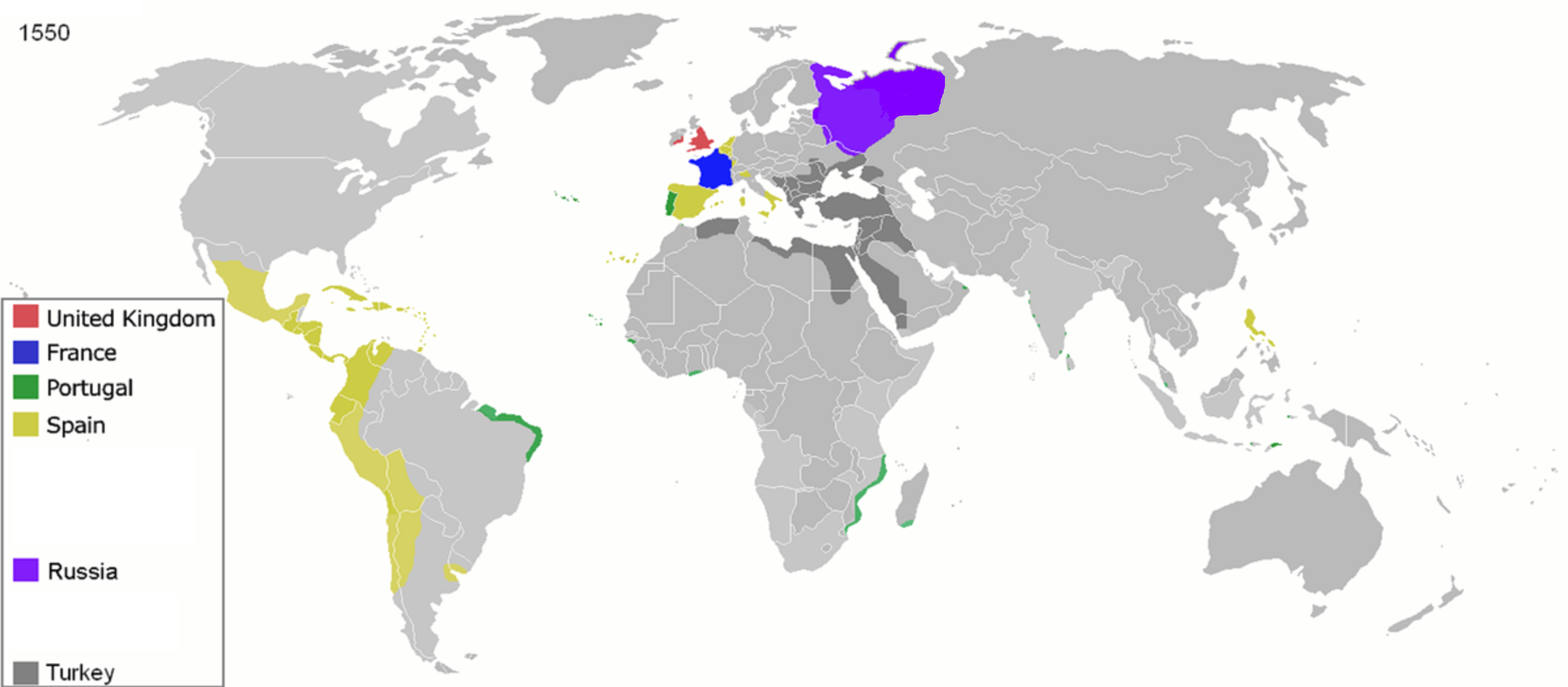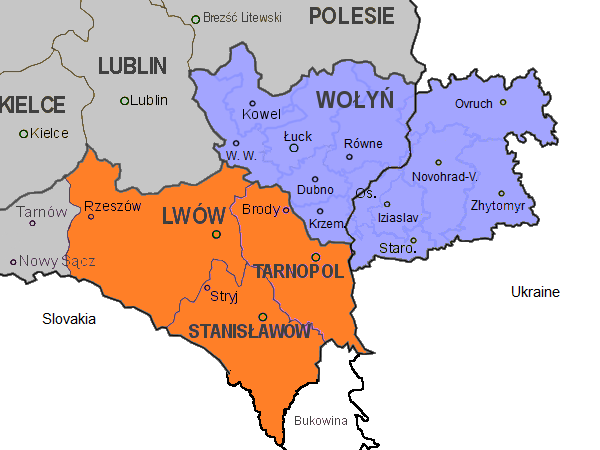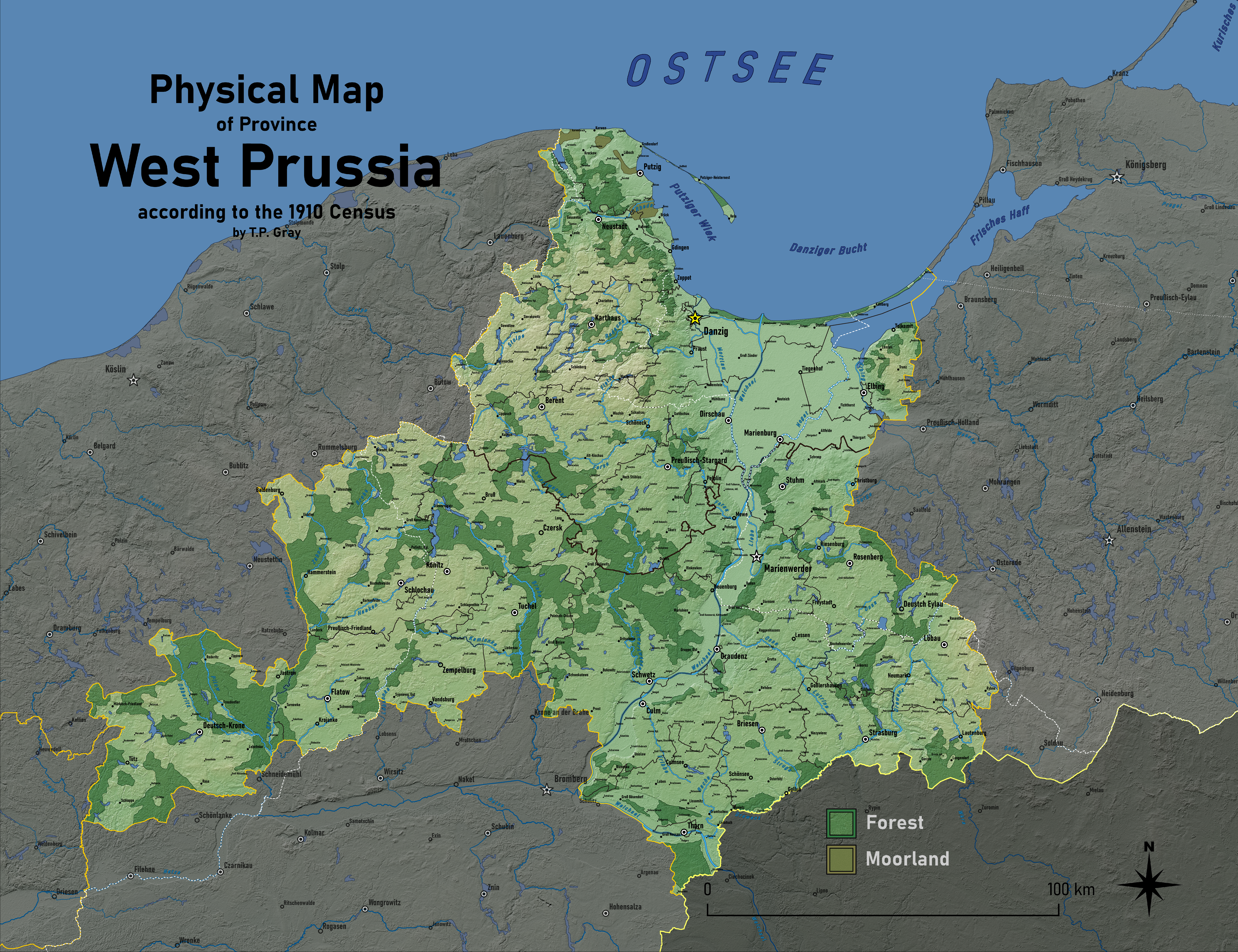|
Volhynian Germans
Volhynian Germans were ethnic Germans who settled in the Volhynia region of the Russian Empire, now part of northwestern Ukraine, from the early 19th century onwards. Their migration was primarily encouraged by Polish landlords seeking to develop agricultural land. The majority of these settlers originated from Congress Poland, with others coming from regions such as East and West Prussia, Pomerania, Posen, Württemberg, and Galicia. Unlike German communities in other parts of the Russian Empire, Volhynian Germans were dispersed across over 1,400 Villages, rather than residing in concentrated colonies. By the turn of the 20th century, their population had grown to approximately 200,000. History The settlement of Volhynian Germans in the Volhynia region began in the late 18th and early 19th centuries. Initially, German craftsmen and merchants had settled in the area as early as the 13th century, contributing to the region's cultural development. However, significant colonizatio ... [...More Info...] [...Related Items...] OR: [Wikipedia] [Google] [Baidu] |
Deutsche Siedlungsgebiete In Osteuropa 1925
Deutsch ( , ) or Deutsche ( , ) may refer to: * or : the German language or in particular Standard German, spoken in central European countries and other places *Old High German language refers to Deutsch as a way to define the primary characteristic of the people of the land with importance given to masculine strength - Dhaithya in Samskrutham (aka Sanskrit) meaning a physically very strong man, who is not concerned about his actions and their consequences that use his strength, as he is blinded by the temporary power he possesses at the moment. *: Germans, as a weak masculine, feminine, or plural demonym * ''Deutsch'' (word), originally referring to the Germanic vernaculars of the Early Middle Ages Businesses and organisations *André Deutsch, an imprint of Carlton Publishing Group * Deutsch Inc., a former American advertising agency that split in 2020 into: **Deutsch NY, a New York City-based advertising agency * Deutsche Aerospace AG *Deutsche Akademie, a cultural organisat ... [...More Info...] [...Related Items...] OR: [Wikipedia] [Google] [Baidu] |
Württemberg
Württemberg ( ; ) is a historical German territory roughly corresponding to the cultural and linguistic region of Swabia. The main town of the region is Stuttgart. Together with Baden and Province of Hohenzollern, Hohenzollern, two other historical territories, Württemberg now forms the Federal State of Baden-Württemberg. Württemberg was formerly also spelled Würtemberg and Wirtemberg Castle, Wirtemberg. History Originally part of the old Duchy of Swabia, its history can be summarized in the following periods: *County of Württemberg (1083–1495) *Duchy of Württemberg (1495–1803) *Electorate of Württemberg (1803–1806) *Kingdom of Württemberg (1806–1918) *Free People's State of Württemberg (1918–1945) After World War II, it was split into Württemberg-Baden and Württemberg-Hohenzollern owing to the different Allied Occupation Zones in Germany, occupation zones of the United States and France. Finally, in 1952, it was integrated into Baden-Württemberg. Stutt ... [...More Info...] [...Related Items...] OR: [Wikipedia] [Google] [Baidu] |
Korets
Korets (, ; ; ; ''Koritz'') is a city in Rivne Oblast, Ukraine. The city is located on the Korchyk river, 66 kilometers to the east of Rivne. It was the administrative center of Korets Raion until the raion was abolished in 2020. Population: History Known since 1150 as Korchesk, Korets was fortified by Prince Theodor Ostrogski in the late 14th century. At that time, the town was part of the Grand Duchy of Lithuania. Between the 15th and 17th centuries, the Korets Castle was the seat of the princely House of Korets that issued from Duke Narimantas of Volhynia. After the death of the last Prince Korecki in 1651, it passed through inheritance to the junior line of the House of Czartoryski and became its main seat until the line died out in the early 1800s. Following the 1569 Union of Lublin, Korzec, as it was known in Polish, became part of the Kingdom of Poland, where it remained for over 200 years, administratively located in the Volhynian Voivodeship in the Lesser Polan ... [...More Info...] [...Related Items...] OR: [Wikipedia] [Google] [Baidu] |
Colonization
475px, Map of the year each country achieved List of sovereign states by date of formation, independence. Colonization (British English: colonisation) is a process of establishing occupation of or control over foreign territories or peoples for the purpose of cultivation, exploitation, trade and possibly settlement, setting up coloniality and often colonies. Colonization is commonly pursued and maintained by, but distinct from, imperialism, mercantilism, or colonialism. The term "colonization" is sometimes used synonymously with the word "settling", as with colonisation in biology. Settler colonialism is a type of colonization structured and enforced by the settlers directly, while their or their ancestors' metropolitan country ('' metropole'') maintains a connection or control through the settler's activities. In settler colonization, a minority group rules either through the assimilation or oppression of the existing inhabitants, or by establishing itself as the de ... [...More Info...] [...Related Items...] OR: [Wikipedia] [Google] [Baidu] |
Merchant
A merchant is a person who trades in goods produced by other people, especially one who trades with foreign countries. Merchants have been known for as long as humans have engaged in trade and commerce. Merchants and merchant networks operated in ancient Babylonia, Assyria, China, Egypt, Greece, India, Persia, Phoenicia and Rome. During the European medieval period, a rapid expansion in trade and commerce led to the rise of a wealthy and powerful merchant class. The European Age of Discovery opened up new trading routes and gave European consumers access to a much broader range of goods. By the 18th century, a new type of manufacturer-merchant had started to emerge and modern business practices were becoming evident. The status of the merchant has varied during different periods of history and among different societies. In modern times, the term ''merchant'' has occasionally been used to refer to a businessperson or someone undertaking activities (commercial or industrial) for ... [...More Info...] [...Related Items...] OR: [Wikipedia] [Google] [Baidu] |
Village
A village is a human settlement or community, larger than a hamlet but smaller than a town with a population typically ranging from a few hundred to a few thousand. Although villages are often located in rural areas, the term urban village is also applied to certain urban neighborhoods. Villages are normally permanent, with fixed dwellings; however, transient villages can occur. Further, the dwellings of a village are fairly close to one another, not scattered broadly over the landscape, as a dispersed settlement. In the past, villages were a usual form of community for societies that practice subsistence agriculture and also for some non-agricultural societies. In Great Britain, a hamlet earned the right to be called a village when it built a church.-4; we might wonder whether there's a point at which it's appropriate to talk of the beginnings of French, that is, when it wa ... ''village'', from Latin ''villāticus'', ultimately from Latin ''villa'' (English ''vi ... [...More Info...] [...Related Items...] OR: [Wikipedia] [Google] [Baidu] |
History Of Germans In Russia, Ukraine, And The Soviet Union
The German minority population in Russia, Ukraine, and the Soviet Union stemmed from several sources and arrived in several waves. Since the second half of the 19th century, as a consequence of the Russification policies and compulsory military service in the Russian Empire, large groups of Germans from Russia emigrated to the Americas (mainly Canada, the United States, Brazil and Argentina), where they founded many towns. During World War II, ethnic Germans in the Soviet Union were persecuted and many were forcibly resettled to other regions such as Central Asia. In 1989, the Soviet Union declared an ethnic German population of roughly two million. By 2002, following the collapse of the Soviet Union in 1991, many ethnic Germans had emigrated (mainly to Germany) and the population fell by half to roughly one million. 597,212 Germans self-identified as such in the 2002 Russian census, making Germans the fifth-largest ethnic group in the Russian Federation. There were 353,441 Ger ... [...More Info...] [...Related Items...] OR: [Wikipedia] [Google] [Baidu] |
Galicia (Eastern Europe)
Galicia ( ;"Galicia" ''Collins English Dictionary'' also known by the Variant name (geography), variant name Galizia; , ; , ; ; see #Origins and variations of the name, below) is a historical and geographic region spanning what is now southeastern Poland and western Ukraine, long part of the Polish–Lithuanian Commonwealth.See also: It covers much of the other historic regions of Red Ruthenia (centered on Lviv) and Lesser Poland (centered on Kraków). The name of the region derives from the medieval city of Halych, and was first mentioned in Hungarian historical chronicles in the year 1206 as ''Galiciæ''. The eastern part of the region was c ... [...More Info...] [...Related Items...] OR: [Wikipedia] [Google] [Baidu] |
Posen (region)
Posen was the southern of two Prussian administrative regions, or ''Regierungsbezirke'' (), of the Grand Duchy of Posen (1815–1849) and its successor, the Province of Posen (1849–1918). The administrative region was bordered on the north by Regierungsbezirk Bromberg, to the west by the Province of Brandenburg, to the south by the Silesia Province, and to the east by Russian Congress Poland. The Posen region was inhabited mainly by Poles practicing Roman Catholicism, although it had a minority of Germans, mostly Protestants. After World War I, most of the territory of this region was ceded to Poland Poland, officially the Republic of Poland, is a country in Central Europe. It extends from the Baltic Sea in the north to the Sudetes and Carpathian Mountains in the south, bordered by Lithuania and Russia to the northeast, Belarus and Ukrai .... Divisions Note: Prussian provinces were subdivided into units called '' Kreise'' (singular ''Kreis'', abbreviated ''Kr.'' ... [...More Info...] [...Related Items...] OR: [Wikipedia] [Google] [Baidu] |
Volhynia
Volhynia or Volynia ( ; see #Names and etymology, below) is a historic region in Central and Eastern Europe, between southeastern Poland, southwestern Belarus, and northwestern Ukraine. The borders of the region are not clearly defined, but in Ukraine it is roughly equivalent to Volyn Oblast, Volyn and Rivne Oblasts; the territory that still carries the name is Volyn Oblast. Volhynia has changed hands numerous times throughout history and been divided among competing powers. For centuries it was part of the Polish-Lithuanian Commonwealth. After the Russian annexation during the Partitions of Poland, all of Volhynia was made part of the Pale of Settlement on the southwestern border of the Russian Empire. Important cities include Rivne, Lutsk, Zviahel, and Volodymyr (city), Volodymyr. Names and etymology *, ; * ; *, ; * or ; *; * ; *; *; * or (both ); Volhynian German: , , or (all ); *, or . The alternative name for the region is Lodomeria after the city of Volodymyr (city ... [...More Info...] [...Related Items...] OR: [Wikipedia] [Google] [Baidu] |
Pomerania
Pomerania ( ; ; ; ) is a historical region on the southern shore of the Baltic Sea in Central Europe, split between Poland and Germany. The central and eastern part belongs to the West Pomeranian Voivodeship, West Pomeranian, Pomeranian Voivodeship, Pomeranian and Kuyavian-Pomeranian Voivodeship, Kuyavian-Pomeranian voivodeships of Poland, while the western part belongs to the German states of Mecklenburg-Western Pomerania and Brandenburg. Pomerania's historical border in the west is the Mecklenburg-Western Pomeranian border ''Urstromtal'', which now constitutes the border between the Mecklenburgian and Pomeranian part of Mecklenburg-Western Pomerania, while it is bounded by the Vistula River in the east. The easternmost part of Pomerania is alternatively known as Pomerelia, consisting of four sub-regions: Kashubia inhabited by ethnic Kashubians, Kociewie, Tuchola Forest and Chełmno Land. Pomerania has a relatively low population density, with its largest cities being Gdańsk ... [...More Info...] [...Related Items...] OR: [Wikipedia] [Google] [Baidu] |
West Prussia
The Province of West Prussia (; ; ) was a province of Prussia from 1773 to 1829 and from 1878 to 1919. West Prussia was established as a province of the Kingdom of Prussia in 1773, formed from Royal Prussia of the Polish–Lithuanian Commonwealth annexed in the First Partition of Poland. West Prussia was dissolved in 1829 and merged with East Prussia to form the Province of Prussia, but was re-established in 1878 when the merger was reversed and became part of the German Empire. From 1918, West Prussia was a province of the Free State of Prussia within Weimar Germany, losing most of its territory to the Second Polish Republic and the Free City of Danzig in the Treaty of Versailles. West Prussia was dissolved in 1919, and its remaining western territory was merged with Posen to form Posen-West Prussia, and its eastern territory merged with East Prussia as the Region of West Prussia district. West Prussia's provincial capital alternated between Marienwerder (present-day Kwid ... [...More Info...] [...Related Items...] OR: [Wikipedia] [Google] [Baidu] |







